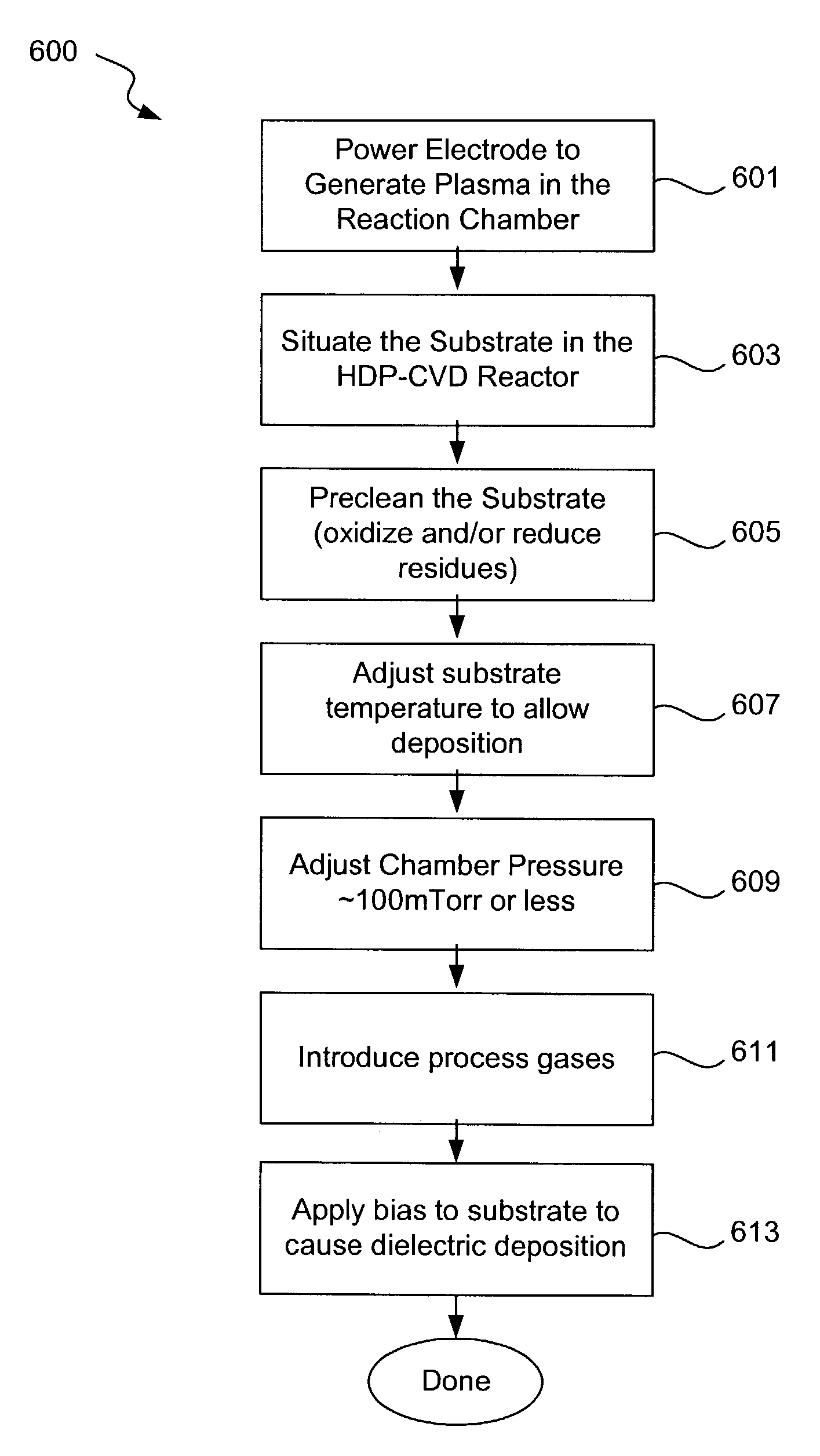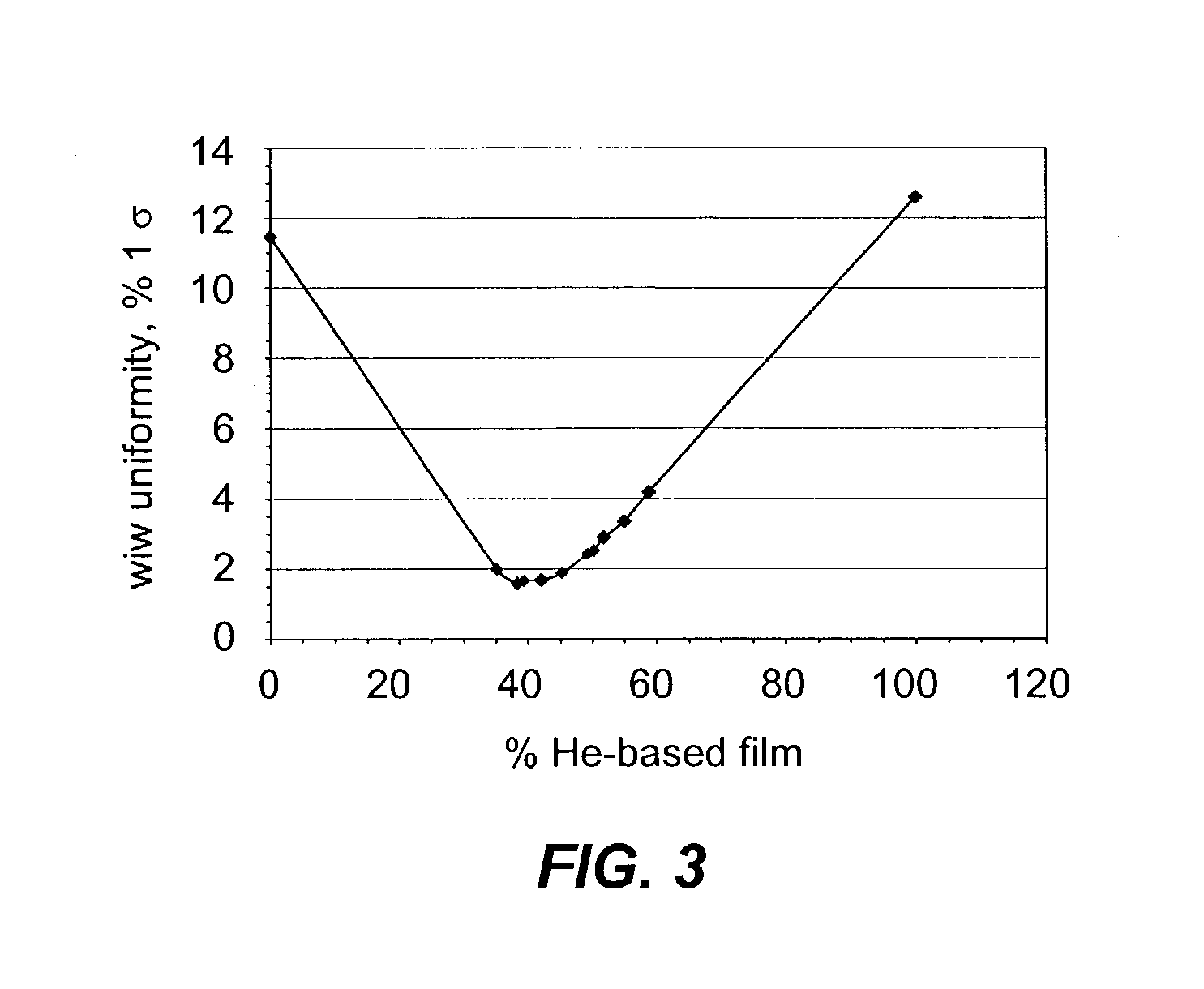Deposition profile modification through process chemistry
a technology of process chemistry and deposition profile, which is applied in the direction of chemical vapor deposition coating, coating, metallic material coating process, etc., can solve problems such as process expiration
- Summary
- Abstract
- Description
- Claims
- Application Information
AI Technical Summary
Benefits of technology
Problems solved by technology
Method used
Image
Examples
example 1
Dielectric Optical Properties
[0091]FIG. 8 shows FTIR absorbance spectra for dielectric films deposited by a standard helium-based HDP CVD process (0 sccm H2 in the process gas) and a hydrogen containing process (1000 sccm H2 in the process gas). Importantly, all of the curves have peaks with almost identical spectral locations and magnitudes. This result indicates that the dielectric formed by a hydrogen-based process in accordance with the present invention has acceptable optical properties relative to the standard dielectric. Also, note the absence of Si—OH and Si—H bonds from the films, as well as the absence of adsorbed H2O.
example 2
Low wiw Uniformity Film Deposited Via Profile Superposition
[0092]FIG. 9 depicts a deposition map for a dielectric film deposited by profile superposition of complementary film layers. The maps bear contour lines indicating the deposition profile. The + and − signs indicate greater and less than average thickness, respectively. The film was deposited in two stages using different process conditions. In stage 1, 70% of the film was deposited using a helium-based chemistry and deposition conditions, as follows:
[0093]
SiH440sccmO274sccmHe490sccmH20sccmLF Power3000WattsHF Power2600Watts
[0094]In stage 2, 30% of the film was deposited using a hydrogen-based chemistry and deposition conditions, as follows:
[0095]
SiH440sccmO274sccmH21200sccmHe0sccmLF Power3000WattsHF Power2600Watts
[0096]The composite film produced by the combined profile superposition of the film layers produced by the helium- and hydrogen-based chemistries had a wiw uniformity of 1.3% 1σ.
example 3
Low wiw Uniformity Film Deposited Via H2 Addition
[0097]FIG. 10A depicts a deposition map for a dielectric film deposited by addition of hydrogen to a helium-based process chemistry during film deposition. The maps bear contour lines indicating the deposition profile. The + and − signs indicate greater and less than average thickness, respectively. The starting helium-based chemistry and conditions were as follows:
[0098]
SiH445sccmO256sccmHe490sccmH20sccmLF Power3200WattsHF Power800Watts
Hydrogen was gradually added until optimum wiw uniformity was achieved, as illustrated by FIG. 10B. The film produced had a wiw uniformity of about 1.3% 1σ.
PUM
| Property | Measurement | Unit |
|---|---|---|
| Temperature | aaaaa | aaaaa |
| Temperature | aaaaa | aaaaa |
| Fraction | aaaaa | aaaaa |
Abstract
Description
Claims
Application Information
 Login to View More
Login to View More - R&D
- Intellectual Property
- Life Sciences
- Materials
- Tech Scout
- Unparalleled Data Quality
- Higher Quality Content
- 60% Fewer Hallucinations
Browse by: Latest US Patents, China's latest patents, Technical Efficacy Thesaurus, Application Domain, Technology Topic, Popular Technical Reports.
© 2025 PatSnap. All rights reserved.Legal|Privacy policy|Modern Slavery Act Transparency Statement|Sitemap|About US| Contact US: help@patsnap.com



